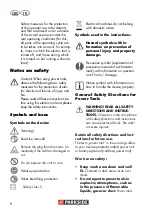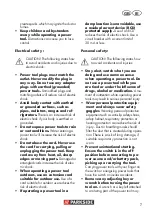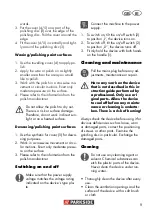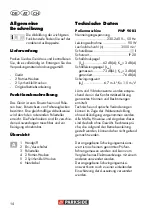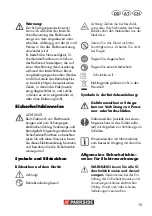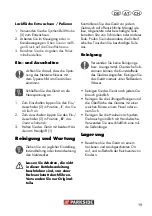
7
GB IE
damp location is unavoidable, use
a residual current device (RCD)
protected supply.
Use of an RCD
reduces the risk of electric shock. Use a
circuit breaker with a current limit of
30 mA or less.
Personal safety:
CAUTION! The following states how
to avoid accidents and injuries:
•
Stay alert, watch what you are
doing and use common sense
when operating a power tool. Do
not use a power tool while you
are tired or under the influence of
drugs, alcohol or medication.
A mo-
ment of inattention white operating power
tools may result in serious personal injury.
•
Wear personal protective equip-
ment and always wear safety
goggles
. Wearing personal protective
equipment such as anti-slip safety shoes,
safety helmet, respiratory protection or
hearing protection can reduce the risk of
injury. Dust or breathing masks should
filter the dust that is created during opera
-
tion
. There is a risk of
lung damage, if
suitable respiratory protection is not
worn.
•
Prevent unintentional starting.
Ensure the switch is in the off-
position before connecting to po-
wer source and/or battery pack,
picking up or carrying the tool.
Carrying power tools with your finger on
the switch or energising power tools that
have the switch on invites accidents.
•
Remove any adjusting key or
wrench before turning the power
tool on.
A wrench or a key left attached
to a rotating part of the power tool may
create sparks which may ignite the dust or
fumes.
•
Keep children and bystanders
away while operating a power
tool.
Distractions can cause you to lose
control.
Electrical safety :
CAUTION! The following states how
to avoid accidents and injuries due to
electric shock:
•
Power tool plugs must match the
outlet. Never modify the plug in
any way. Do not use any adapter
plugs with earthed (grounded)
power tools.
Unmodified plugs and
matching outlets will reduce risk of electric
shock
•
Avoid body contact with earthed
or grounded surfaces, such as
pipes, radiators, ranges and ref-
rigerators.
There is an increased risk of
electric shock if your body is earthed or
grounded.
•
Do not expose power tools to rain
or wet conditions.
Water entering a
power tool will increase the risk of electric
shock.
•
Do not abuse the cord. Never use
the cord for carrying, pulling or
unplugging the power tool. Keep
cord away from heat, oil, sharp
edges or moving parts.
Damaged or
entangled cords increase the risk of elec-
tric shock.
•
When operating a power tool
outdoors, use an extension cord
suitable for outdoor use.
Use of a
cord suitable for outdoor use reduces the
risk of electric shock.
•
If operating a power tool in a
Summary of Contents for PWP 90 B2
Page 3: ...5 6 1 2 3 4...
Page 24: ...24...






